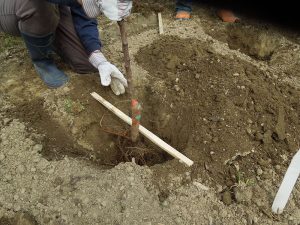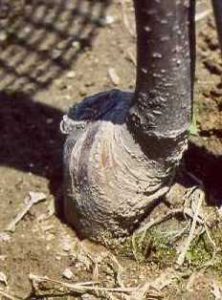Planting and Early Care
Planting in a good site can extend the lifespan of trees and enhance their ability to bear fruit. Soil depth, soil drainage, the potential for spring frost and the amount of sunlight are important things to consider when selecting a site. For peach trees and other tender fruits, higher elevations and sloping ground are preferable to lower sites or areas that are protected from wind since they tend to be warmer on the coldest nights when the sky is clear and the weather is calm. Select sites with good air flow and avoid areas surrounded by dense woodlots and low spots because cold air will be prevented from moving and lead to an inversion where the air is colder at lower elevation.
Trees are tolerant of a wide range of soil types, but need a minimum of 18 inches of soil. Many areas in Maine have shallow soil. Fruit trees planted in these areas are typically small or stunted and prone to leaning or falling over.
Soil pH should be in the range of 6.0 to 7.0. When the soil pH is below 5.5, trees will grow poorly. A soil test should be done before planting to determine the soil pH and how much lime is needed to raise it to within the optimum range. Adjusting the pH with lime is much easier before trees are planted. A soil test also measures the amount of nutrients contained in the soil. Prior to planting, fertilizer or compost can be tilled into the soil where deeper roots can absorb the nutrients they contain. Thoroughly mixing compost or fertilizer with soil will prevent the burning of roots. Most soils contain sufficient fertility for fruit trees, but soil pH is too acidic in areas where blueberries thrive.
All fruit trees should be planted in well-drained soil since flooding favors root rot and asphyxiation. Apple trees are very sensitive to flooding and can be killed by long periods in waterlogged soil.
Fruit trees are most productive when in full sun. In order for the tree to form flower buds and grow fruit, its requires sunlight.

To plant a tree, dig a hole wide enough to allow the root system to fit without the roots wrapping around the edge. The hole should be deep enough to allow the tree to be planted with the graft union just above the soil line. Dwarf and semidwarf trees should be planted with the graft union one to three inches above the soil. If the graft union is planted below the soil, roots will form on the trunk above the graft union, and the tree will be grow to a full sized tree rather than a dwarf or semidwarf.

Cover the roots with soil, putting nothing else in the planting hole. Adding fertilizer to the planting hole can burn the roots and stunt the tree. Compost and other fertilizers can be tilled into the soil before planting. Gently pack the soil in the hole to remove air pockets.
The trees should be watered after planting with two to five gallons per tree, added slowly so that the water soaks into the soil. When rainfall is insufficient, each tree can be watered at a rate of five gallons per week. Newly planted trees require water during periods of dry weather. However, avoid over-watering since the roots are very sensitive to flooding.
For best tree growth, remove weeds growing under the tree. They compete for water and nutrients, and create problems with trunk boring insects and voles. Bark or wood chip mulch can be used to inhibit weeds. Avoid straw or fabric mulch since they favor root rot and encourage voles, mice-like rodents, which feed on tree bark. When using herbicides to control weeds, avoid contacting the trunks of young trees since many herbicides can be absorbed through the thin bark and harm the tree. Allow groundcover to grow back in late summer to insulate the soil from freezing temperatures in winter.
